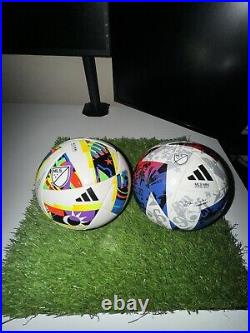






The Adidas Jabulani was the official match ball for the 2010 FIFA World Cup held in South Africa. Here’s a detailed overview of the ball. Design & Inspiration: The name “Jabulani” comes from the Zulu word meaning to celebrate. The ball’s design featured a mix of vibrant colors, with a unique pattern representing South African culture and the country’s 2010 World Cup theme. The Jabulani was notable for its eight-panel design, which was a departure from the traditional 32-panel structure seen in most previous World Cup balls. This design aimed to improve the ball’s stability in flight and make it more aerodynamic. It was made with a synthetic TPU (thermoplastic polyurethane) cover, and Adidas used its “Grip’n’Groove” technology for added texture and control. The ball was designed to be more stable and consistent, with a slightly lighter weight compared to previous World Cup balls. However, it received mixed reviews from players and teams due to its unpredictable flight behavior. The ball’s lighter weight and smooth surface caused it to behave erratically in flight, leading to complaints from goalkeepers and players, particularly in terms of its trajectory and how it swerved unpredictably. Size: The Jabulani was available in Size 5, which is the standard size for adult professional and international soccer matches. Material & Technology. It was designed with Adidas’ “Power Balance” technology to enhance its flight characteristics. The ball had a 3D surface with a unique texture intended to improve grip and control, especially in wet conditions. Use in the World Cup. It was used in all matches during the 2010 FIFA World Cup, which was held in South Africa. It became a topic of controversy during the tournament, with many players stating they had difficulty controlling the ball or adjusting to its flight dynamics. Despite the criticism, the Jabulani featured in some memorable moments, including striking goals and powerful shots during the tournament. As the official World Cup ball, the Adidas Jabulani is highly sought after by collectors, particularly in mint or unused condition. It’s often seen as a piece of World Cup history, especially for fans and collectors of soccer memorabilia. Some players, including goalkeepers like Iker Casillas and Gianluigi Buffon, famously criticized the ball for its unpredictable flight. Several players mentioned that the Jabulani could swerve in the air unexpectedly, making it difficult to judge and control. Despite the controversies surrounding the ball’s performance, the Jabulani remains a memorable part of the 2010 FIFA World Cup and is often remembered for both its unique design and its association with the tournament. Custom clearance is not our responsibility. If custom holds your ball we are not responsible.




























































